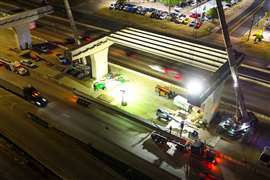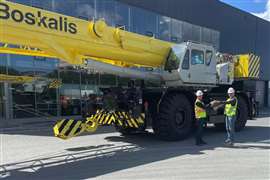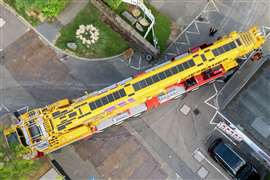Read this article in Français Deutsch Italiano Português Español
What’s going on in the boom dolly market?
03 April 2024
Varying and complicated market issues have caused a retraction in boom dolly market. While demand is considered steady, the number of companies now making boom dollies has decreased. Four years ago, four companies produced and marketed boom dollies – Greenfield Products, HMR Supplies, Nelson Manufacturing and TransWorld Manufacturing.
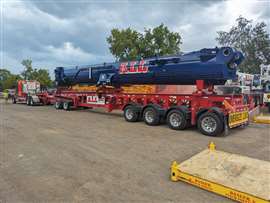 Nelson Manufacturing builds boom dollies for all major crane manufacturers. The current challenge in the market is crane availability and boom dolly production lead time. The goal is to have the boom dolly complete when the crane is delivered.
Nelson Manufacturing builds boom dollies for all major crane manufacturers. The current challenge in the market is crane availability and boom dolly production lead time. The goal is to have the boom dolly complete when the crane is delivered.
Today, just Nelson Manufacturing and TransWorld Manufacturing are producing boom dollies, and TransWorld’s Crystal Dieleman recently announced that the company would be pursuing a new direction in the realm of open-source technology. While the company will complete its current orders for boom dollies, TransWorld Manufacturing will not be accepting new orders. The company will be repurposing its facility for another use and will focus on offering design, engineering and consulting services to its clients.
OEM shifts
In 2022, Greenfield Products shifted its focus and exited the boom dolly business. It’s boom dolly designs were passed along to Nelson Manufacturing.
HMR Supplies, a division of CR Holland Crane Service, started making boom dollies in the late 1980s. The company was recently acquired by Barnhart Crane & Rigging, and because of this, its operations are in flux, a company spokesperson said.
“We are planning to stay in the market and get back to the level we were at, but we have to decide a path yet,” said a source from the company.
That leaves Nelson Manufacturing as the sole provider of boom dollies at the moment. President Tony Niese said the market for boom dollies is steady and he expects it to remain steady. However, there are challenges in the market.
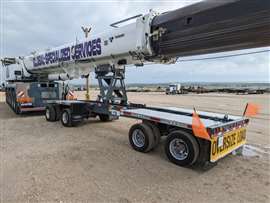 Boom dollies are most often built for new 5-axle all-terrain cranes.
Boom dollies are most often built for new 5-axle all-terrain cranes.
“A challenge right now is crane availability plus our lead time,” he said. “When you compare our lead times now to what they have been historically, we currently are maintaining a competitive lead time. The challenge is that some cranes are on the ground ready to go to work and some might be six to eight months out. Our team works with our customers on their crane availability, which helps us coordinate our boom dolly production in an effort to have the boom dolly complete when the crane is available.”
Popular add ons
Most boom dollies are produced for 5-axle all terrain cranes, Niese said.
“The most popular attributes continue to be the robust chassis design on the traditional dollies,” he said. “Most all of our dollies are made with air-ride suspension and air locking pins, as those have been popular options throughout the years. One of our more popular add-on options is for outrigger pad racks on the rear of the dolly.”
Nelson Manufacturing builds boom dollies for all major crane manufacturers and all the various models they produce.
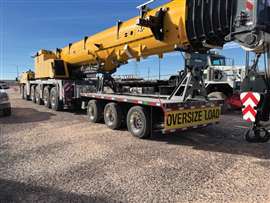 Boom dollies are generally customized for where the crane will be operating. Different parts of the country have different axle weight standards, so one particular boom dolly will not work for all areas.
Boom dollies are generally customized for where the crane will be operating. Different parts of the country have different axle weight standards, so one particular boom dolly will not work for all areas.
“It is important to know where the customer is going to operate,” said Niese. “Different parts of the country have different axle weight standards, so one particular boom dolly will not work for all areas. For example, an all-terrain crane requiring a boom dolly in Minnesota may require a closed group quad axle. The same crane in North Carolina may require a tandem axle lightweight boom dolly.”
Dieleman agreed that demand for boom dollies is “pretty strong.”
“New crane sales are still months out,” she said. “Without a lot of new cranes in stock, we’re seeing more used sales for both crane and dollies.”
She said that challenges in the boom dolly market remain the same: evolving DOT requirements, fluctuating material and component costs and lead times.
“Lead times might never be back to 2019 windows,” she said.
Customizable dollies
Dieleman said boom dollies are primarily built for 100 to 500-ton capacity ATs. Customers are looking for a boom dolly that is light and customizable.
“Our dollies are the lightest available. After reconditioning several 20-year-old dollies this past year, I can tell you they also last a long time,” she said.
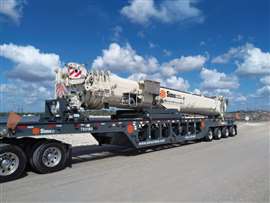 Boom launch trailers are another tool for cranes that can’t be transported over the road. The market for these trailers is picking up, according to Nelson Manufacturing.
Boom launch trailers are another tool for cranes that can’t be transported over the road. The market for these trailers is picking up, according to Nelson Manufacturing.
While boom dollies are necessary in many states to move cranes over the road, Dieleman said market conditions are difficult to understand.
“To be perfectly honest, the thing about boom dollies is that no one actually wants to buy one,” she said. “They are not a piece of equipment that end users make money with. It is often a product where someone is looking for the cheapest possible solution. Therein lies the nuance because of the risk associated with the entire mobilization process.”
Because of this, TWM has significant investments in technically advancing product design.
“We’ve developed prototype hydro-gas boom dollies, steerable dollies and more,” she said. “In all actuality, the dolly should match the driving and steering characteristics of the crane. But all of that comes with a price tag. Absent the demand for technical boom dollies, we focus on safety first.”
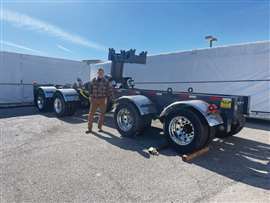 After completing current orders for customers, TransWorld Manufacturing will cease manufacturing boom dollies and focus on offering design, engineering and consulting services, with new boom dolly technology as a part of its services.
After completing current orders for customers, TransWorld Manufacturing will cease manufacturing boom dollies and focus on offering design, engineering and consulting services, with new boom dolly technology as a part of its services.
Dieleman said one thing that is not discussed enough is the connection from the crane boom to the dolly tower.
“Back in the 1990s, a lot of people used a 2-point connection,” she said. “After some issues, most moved to a 3 or 4-point connection for the added stability. We still get calls asking for a 2-point connection because it is faster to hook up. But faster does not always mean safer.”
As well, a boom dolly is different from a traditional trailer.
“Traditional trailers are pulled from the front,” Dieleman said. “A boom dolly tower is installed on top of the dolly frame and connects to the crane boom. So, with the main connection point hitting the frame somewhere between the first and third axle, depending on the setup, you have the first 1-2 dolly axles being pushed from behind, while the rear dolly axle(s) follows. This ‘pushing’ force gives the dolly much different driving characteristics.”
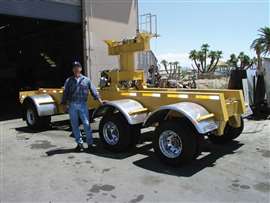 An early TransWorld Manufacturing boom dolly featured a 2-point dolly to crane connection, which is no longer standard.
An early TransWorld Manufacturing boom dolly featured a 2-point dolly to crane connection, which is no longer standard.
Because of this, the high center of gravity, travel at high speeds, imperfect road conditions and the fact that cranes are designed to travel with the boom over the front, it is important to build in as much stability to the configuration as possible.
“Add in the fact that we often don’t have a tremendous weight budget to factor in stability, a cradled or 4-point crane to dolly connection might be one of the most important things we can do to ensure stability, and therefore safety,” she said. “With very little information available on boom dollies in general, it’s important to have these broad conversations at an industry level and share best practices.“
STAY CONNECTED


Receive the information you need when you need it through our world-leading magazines, newsletters and daily briefings.
CONNECT WITH THE TEAM










